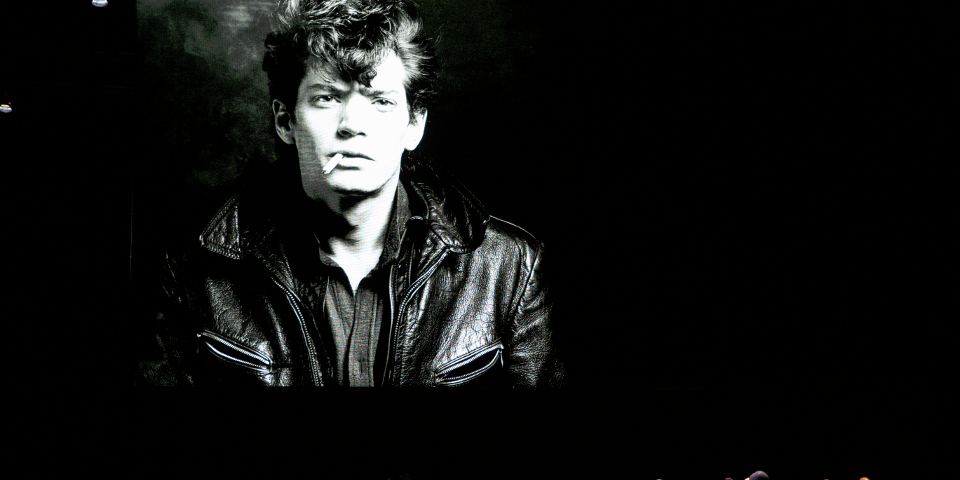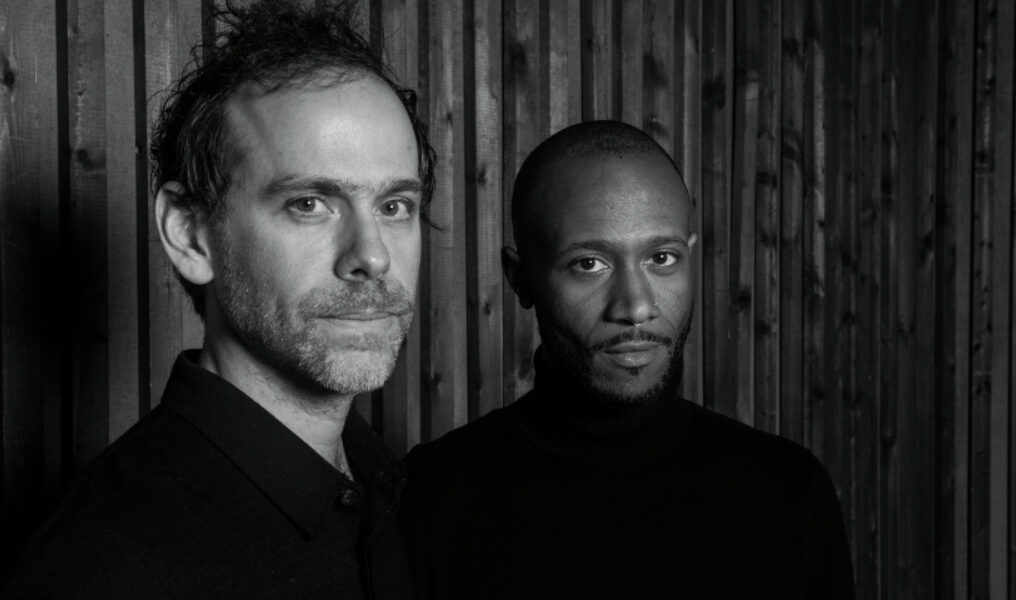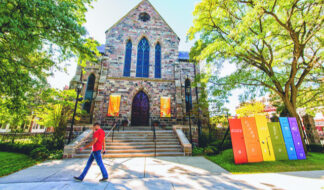It's been 30 years since his death and still Robert Mapplethorpe remains a provocative figure. In a new performance piece, titled "Triptych (Eyes of One on Another)" presented by the University of Michigan's University Musical Society March 15 to 16, music, poetry and photography come together in a theatrical context. The mediums serve to explore the impact of Mapplethorpe's work and the impression it had on the lives and careers of composer and Cincinnati native Bryce Dessner and librettist Korde Arrington Tuttle.
Revisiting Mapplethorpe's life, it's impossible to ignore the controversies surrounding his work, which only intensified following his death in 1989. But the Mapplethorpe story begins modestly. He was born on Nov. 4, 1946, in the borough of Queens in New York City to a strict Roman Catholic family, one of six children. His father was an electrical engineer and his mother a homemaker.
Though Mapplethorpe showed no initial photographic promise in his younger years, after high school he majored in graphic arts at the Pratt Institute in Brooklyn but left before finishing his degree. During his time there, he met artist Patti Smith and it wasn't long before the two moved in together and began a relationship. Soon after, he took up photography.
In a 2016 book about her love affair with Mapplethorpe, Smith said, "Robert took areas of dark human consent and made them into art. He worked without apology, investing the homosexual with grandeur, masculinity and enviable nobility. Without affectation, he created a presence that was wholly male without sacrificing feminine grace. He was not looking to make a political statement or an announcement of his evolving sexual persuasion. He was presenting something new, something not seen or explored as he saw and explored it. Robert sought to elevate aspects of male experience, to imbue homosexuality with mysticism. As Cocteau said of a Genet poem, 'His obscenity is never obscene.'"
That obscene-less obscenity spoke to composer Dessner, who transformed his passion for Mapplethorpe's work into "Tritych."
"As a teenager, I was told by the authorities that I was not allowed to look at Mapplethorpe's photographs," Dessner said. "And that these tremendous works of art were not art at all, but pornography. This censorship made a significant impact on my life at the time and on my decision to pursue art and music as a career. Thirty years later, I have decided to respond in my own way and to look at these pictures again myself, and through the eyes of my wonderful collaborator, the librettist Korde Arrington Tuttle. This project has challenged me more than any work to date and I am honored to share this journey with this ensemble."
Exploring the Medium
When he started taking photographs in the late '60s, photography was only starting to be seen as a legitimate art form. Mapplethorpe took his first images with a Polaroid and, by 1973 he hosted "Polaroids," his first show. Shortly after, Mapplethorpe acquired a Hasselblad medium-format camera from his patron and lover art curator Sam Wagstaff.
Mapplethorpe started taking photos of his colorful circle of friends, which included artists, musicians and film stars. He also began exploring the S&M scene both personally and through his work, creating graphic images that depicted scenes such as fisting and bondage. He would become most well-known, perhaps, for a self-portrait that featured the photographer with a bullwhip sticking out of his naked backside.
Reflecting on his body of work in 1988 for ARTnews, Mapplethorpe said, "I don't like that particular word 'shocking.' I'm looking for the unexpected. I'm looking for things I've never seen before. I was in a position to take those pictures. I felt an obligation to do them."
Yet, even if he didn't like the word, most of those who saw the images agreed that 'shocking' was a fair description of his work. By the mid-'80s he had branched out. He did a photo book on female bodybuilder Lisa Lyons and focused on the black male nude in another. His work also extended to still life shots of flowers that earned him a fair amount of popularity, too.
And as Mapplethorpe's health began to fail, his output increased. Patricia Morrisroe, his chosen biographer, later revealed in her book that, as he declined, Mapplethorpe's assistants did the majority of the set-up in his photography. He died of AIDS related causes on March 9, 1989.
Even after his death, Mapplethorpe's work inspired controversy. Only weeks after his passing a traveling solo exhibit of his works called "The Perfect Moment" became the subject of controversy when the Corcoran Gallery of Art in Washington, D.C., decided to cancel the show. Curated by the Institute of Contemporary Art, the ICA became embroiled in controversy regarding the funding it received for the show from the National Endowment for the Arts from Congress. Then, Dennis Barrie, director of Cincinnati's Contemporary Arts Center, featured the exhibit in his museum. In response, Barrie was charged with obscenity by the Hamilton County prosecutor.
Congress continued debating the funding's justification amid arguments that Mapplethorpe's images were full of homoerotic and sadomasochistic themes and questioned whether they even constituted art. Even today, those questions remain an issue, but as a result of this attention, awareness of Mapplethorpe's work grew significantly.
"In 1990 in Cincinnati, Ohio, I was a 14-year-old teenager around the time when The Perfect Moment came to the CAC," Dessner said. "It was a big cultural moment in time, and an even bigger moment after Cincinnati police and the Hamilton County prosecutor at the time shut down the museum and put Dennis Barrie in jail for a week. It was kind of a lightning rod moment in my childhood that I didn't fully understand at the time. But, for me, it brought up all kinds of issues."

An Enduring Influence
Today, Dessner said he doesn't see the Mapplethorpe images in the same light.
"The way that we look at those photos, now that I can look at them, is very different in 2019 than it was in 1990, or in 1978 or whenever it was that certain images were shot. Doing it now, for me," Dessner said, "almost 30 years later from this experience I had as a teenager it's also been important to approach it with an open mind and from a different point of view."
Significant time was spent, said Dessner, conceiving and conceptualizing the show.
"This is something I've been thinking about for a long time," he said. "I love Mapplethorpe's photographs so I came to do it out of respect for the unbelievability of certain images."
In creating the show, Dessner said he immersed himself in Mapplethorpe.
"I spent time sort of inhabiting his world, whether it be his deep relationships with Patti Smith and Sam Wagstaff or the things he left us. For instance, the Getty Museum in L.A. has an unbelievable collection of, really, his entire archive. He was pretty meticulous in the way that he kept things."
For his part, Tuttle, the show's librettist, said he's too young to recall the Mapplethorpe controversy.
"I was born in 1990, so the experiential knowledge doesn't live in my body," he said. "But the lived experience of what's presented in his work and the perspective and the point of view always stirred me."
Regardless of his age, Tuttle said he has been impacted by Mapplethorpe.
"The project is meaningful to me on so many levels … history is alive, and I believe this is a story about all of us."
For more information about "Triptych (Eyes of One on Another)," presented at UMS' Power Center in Ann Arbor, visit ums.org/performance/mapplethorpe.











